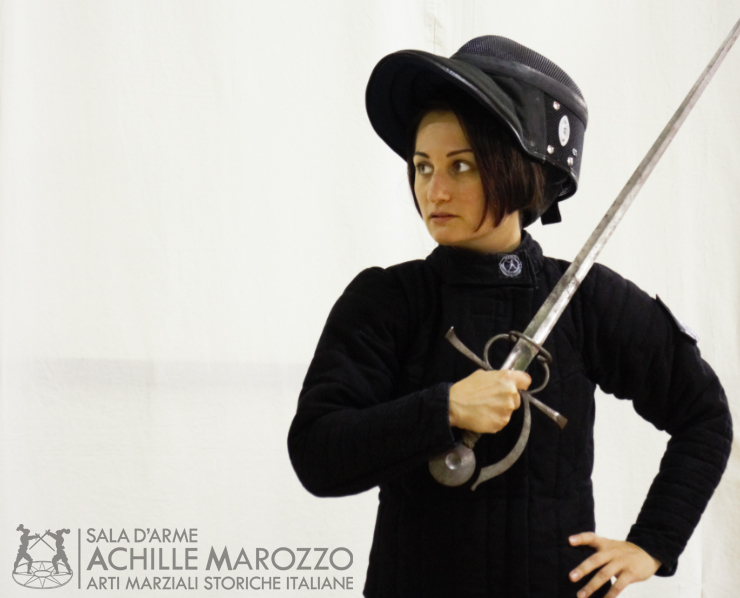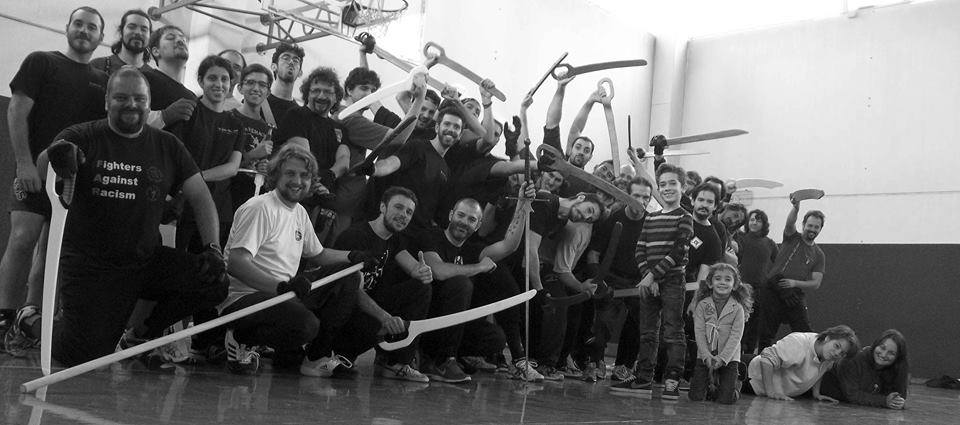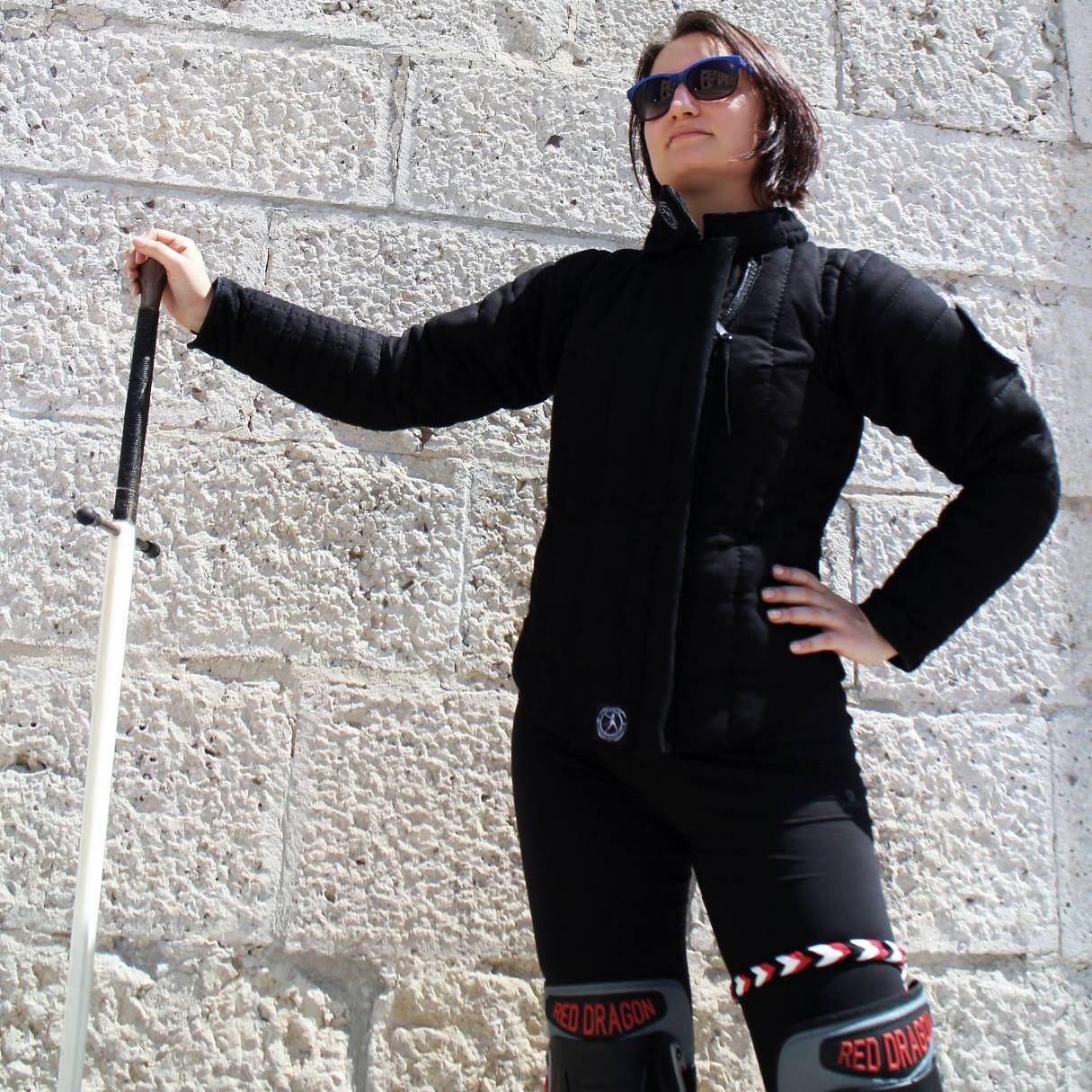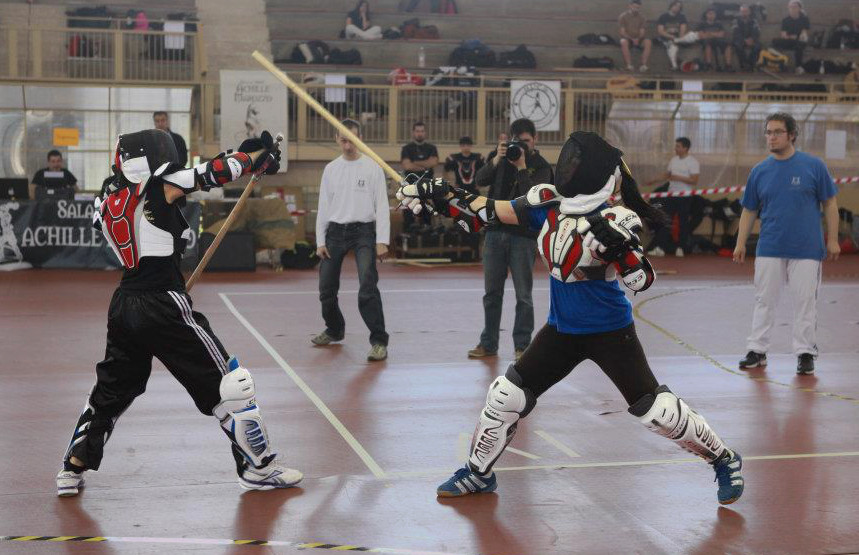Anna Pighin, of Udine, Italy, has been studying Historical European Martial Arts (HEMA) since 2009. She focuses on the Bolognese School, in all its wonderful facets, although the side sword will always have a special place in her heart. She has been the founder and chief instructor of her local club “Sala d’Arme Achille Marozzo (SAAM)- Friuli Venezia Giulia” since 2012. Her students, friends, and fellow HEMAists call her a “paladin”, a “woman of steel”, strong-willed, confident and capable, at the same time proactive and full of ideas, a loyal friend and the soul of her club. She kindly told us about her experiences and HEMA in Italy.

E: What got you into HEMA?
A: I hope you can hear the dice rolling in the background, because that’s one of the reasons that got me into HEMA: I had a warrior character in Dungeons & Dragons. I still remember her, a dwarf with a real fondness for her sword and her rum. I wanted to interpret my role better. On the fondness for rum I had no issues, the sword proved more difficult. I was living in Florence at the time, and I googled, “scherma medievale” [medieval fencing], and one of the first links was SAAM, at around 10km from where I lived, and that of F.I.S.A.S., 500m from me. I looked at both sites, and I let myself to be convinced by the graphics of the SAAM one, that was more up-to-date and complete compared to the other. I showed up at the club on a Tuesday evening and I never left. In 8 years in SAAM I did practically nothing “medieval”, but almost only renaissance!
Another reason is much more personal. Living in Florence, 400km from home, completely alone without knowing anyone, was an experience that, for a 20 year old girl, was not easy to manage, and I didn’t have the same strength I have now, at all. With SAAM I found a second family and a sport that made me feel alive. I had a way to feel my errors on my skin: Every bruise is a failed action or a distraction during the assault. How I am now as a person owes a lot to these 8 years – Do you think it is easy for a person with my attitude to live in a world dominated by men?

E: Did you have any previous experience in martial arts or fencing?
A: Not with fencing. Well, to be honest, I had some contact with it. Giulia Rizzi, one of the athletes in the epee fencing Olympic team, was one of my classmates for many years. As much as she’s always been a very humble person, her victories spoke for her. Surely having a clear solid example of a girl “good with weapons” pushed me at the time to look for something similar.
Speaking of martial arts in general, I practiced Judo for 2 years. I got lots of the discipline and martial mindset that helped me to teach HEMA. We are a de facto martial environment, at least in SAAM, where it is necessary for the instructors to be an example. I think that oriental martial arts can teach us a lot, though we need to adapt it to our needs.
E: How did you come to be an instructor?
A: This is a really interesting story.
Sometimes in life you find yourself at a crossroads. I was 22 years old when I realized that in a year I’d have to leave Florence and go back to Udine, my home, in the far North. I’ve always been a very diligent girl and in a way very devoted to duty – which, to be honest, has been counterproductive sometimes. So when I realized this I had these choices in front of me: stay in Florence and keep on fencing, going back to Udine and look for some historical fencing class in my city, going back to Udine and open a SAAM. My parents would probably have taken me home by force, and confined me to a mental ward, if I had stayed in Florence. I would have understood them!
Since my head is hard as a rock I decided to walk the hardest path – full of thorns and other dangers – repeating to myself that difficulties spice up your life. Not all instructors in SAAM were in favour of me taking the exam and starting to teach. So I must thank my instructors (Alessandro Battistini, Iacopo Venni, Gioacchino Cecchi) for taking my side even against those who believed I wasn’t ready yet. In hindsight I understand those reservations completely, tied mainly to my age then compared to the average age of the SAAM students. So just a week past my 23rd birthday in June I took the exam for SAAM Assistant Instructor in Bologna, and after three months I began teaching.
It was…hard, in the beginning. I was alone, very young, had little equipment to offer my students. But I was fiercely pushed by the naivete of my youth, by my stubborn determination and by my hate of failure, and after five years I had more than 30 students.
I often joke that here in the North we are the swords in the darkness, the watchers on the walls – even if I enjoy breaking barriers down far more than defending them – but thinking back to the beginning and me being alone – without my brothers in arms from Florence, without my instructors – was as hard as being between ice and snow. I’d say that the hard way was the right way to reach the top, and the view from here is worth all the hardships I faced.

E: What are your favourite teaching moments, and what advice would you like to give us as a teacher?
A: Obviously when one of my students succeeds as an athlete, I am very happy and satisfied, because victory – of any type – gives an incredible energy to the group, an energy that can be used as a collective stimulus. However, the best part of teaching is that particular relationship that develops between student and teacher. I have to thank all the students I’ve had during these years, because while I have taught them fencing, they have taught me about life.
Each of us has a different body. While we might like the fighting style of another person, it is not necessarily the right one for us. We have to focus on our own merits and on our own defects, in order to strengthen the first and reduce the second. Women, in the majority of cases, are physically disadvantaged compared to men. Most of the time we are shorter, often less strong. We must therefore focus primarily on agility and coordination, and be able to trick our opponents – women are the queens of tricks!

E: Your group (SAAM) is possibly the largest HEMA body in the world. Tell us the history behind the organisation and your particular chapter.
It is one the oldest associations in the country; in February 2017 it is going to be 20 years old, even if obviously its founders got close to the HEMA world before. I believe this year we’ll surpass 700 members. A big number, but if we compare it to other sports it is comparatively small, and we should not forget it.
SAAM was founded in Bologna in 1997, and from there it expanded all over Italy. We have around 40 clubs. (It’s honestly hard for me to keep track of them all now.) I can proudly say that I contributed to the birth of 3 chapters in the last 5 years, hopefully increasing them to 5 shortly.
I think there are a lot of myths to dispel regarding SAAM. First of all, I’ve been asked many times from people from other associations: “What’s your salary?”; I smile because while I teach and reserve an overwhelming amount of hours for my chapter during the week, well beyond practice time, I have never seen a single cent coming my way and I’ve often had to pay from my own pocket. In SAAM we have a clear set of principles. One is that we should not teach for money. We believe that those who practice HEMA for a salary could be tempted to teach something that they don’t know, because they have to make a living through what they teach. Also, the goal of our association is to spread our Art, and in order to spread it it must be approachable. Low prices (for everything: courses, events, seminars) allow us to reach many more people – especially considering the current economical crisis, that is still felt in our country. These low prices are maintained through not paying instructors, and using equipment as economical as possible.
For years we’ve been met with barely hidden disappointment due to our choice to use rattan sticks instead of steel. For steel weapons we require FIE certified protection of 1600N for head and torso, 800N for arms and legs. Being such a big association results in everything we do causing a stir. In Italy it is the bad things that are usually get attention rather than the good deeds. If one of our students were to get hurt during training due to the fact that he wasn’t using appropriate protective gear for the weapon he was fencing with, it would have quite the resonance. Because being so many, the chances of an accident are obviously greater. This is the reason that kept us far from steel, given the costs of both protective gear and weapons. Only in the last few years that we started to use steel regularly in SAAM, since the large numbers allow us to buy more costly club materials in sufficient numbers without burdening the individual. Now every club has a good stock of nylon weapons and some steel ones, too.
Since our goal is that of spreading the art, there’s always been a real interest in creating new teachers who then could open new chapters. This proved a winning asset for SAAM. In the end, being a part of such a big and at the same time dynamic association gives you a strong sense of belonging, a sense of family that helps to create loyal members. At least that’s what I experienced as a student and what I try to recreate as a teacher.
Teaching, sharing, volunteering work, low prices and sense of family; this is how SAAM developed over the years.

E: Tell us a little bit about the HEMA scene in Italy
A: This is a truly complex question, and my answer is not going to be exhaustive. I don’t think I’m the best person to answer, because I’m not part of the upper echelon managing the national scene. What I know is what I’ve been told, what I’ve read on social networks, and how I interpret that. I believe that HEMA Italia is in a situation similar to the Italian nation in general. In 1861, we officially became a united country, but centuries of quarrels cannot be erased overnight. Internal disputes, even if greatly diminished in the last century and a half, are not extinct – the will of a cultural unification has been completely missing. The situation in Italian HEMA seems to mirror that. There was, on one side F.I.S.( Italian Fencing Federation, which takes our fencers to the Olympic games) and its branches that manage coaching formation (A.I.M.S. – National Fencing Masters Academy) and certification (A.N.S. -Fencing National Academy) and on the other side an explosion of HEMA associations. It’s not completely clear to me why that happened, but the gist is: due to some “difference of priorities” with F.I.S. there has been a series of refusals to recognise HEMA as a fencing discipline. What’s more, there used to be a competitive fencing tournament, the famous “ Storicombat”, which has fallen into nothingness as well.
There are lots of entities in Italy now that should cover both the instructors’ formation, the competitive scene and the research and publication scene: just to name a few: A.I.M.A., S.P.A.D.A., V.A.D.I., recently A.N.H., and many more I probably don’t know of, but strangely the “Hema Italia” group disbanded after only a few years.
In conclusion, if I had to take a picture now – and certainly it is going to be partial and incomplete – of the state of HEMA Italia , I’d say there are many strong scenes, but they don’t collaborate much or at all on an interregional or national level. This, I believe, is because many people want a certain role and/or prestige and do not want to share it with others.
My hope is to improve the relationship with F.I.S. and its branches, creating a single HEMA path, parallel with Olympic fencing and equal to it, introducing a new series of competitive events (possibly with better rulesets than the previous one), a new path to create instructors and, mainly, a research team that can continue the study of the treatises and various publications.
E: What are your future plans?
A: In the HEMA world, I want to consolidate historical fencing in our region, Friuli – Venezia Giulia. We plan to open new chapters, and create a better connection with the different HEMA scenes. I’m the president of my club, and I want to form a group of people who are able to go on without me, because I firmly believe in the passing of knowledge and in legacy.
As for me personally, this year I will take the examination for Olympic fencing instructor, and – life commitments permitting – I would also like to take the AIMA and FIS instructor exams. Also this year I definitely want to return to the podium. I hope to have the opportunity to participate in some competition.

